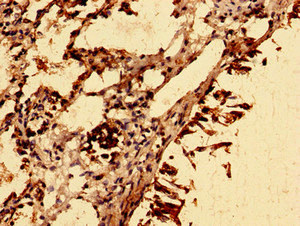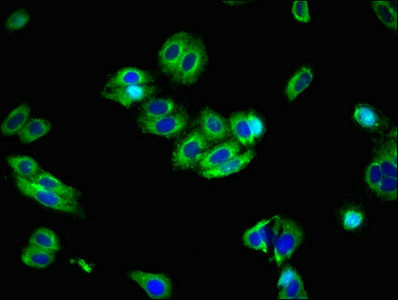SLC39A8 Antibody
产品详情
-
产品名称:Rabbit anti-Homo sapiens (Human) SLC39A8 Polyclonal antibody
-
Uniprot No.:Q9C0K1
-
基因名:SLC39A8
-
别名:SLC39A8 antibody; BIGM103 antibody; ZIP8 antibody; PP3105 antibody; Zinc transporter ZIP8 antibody; BCG-induced integral membrane protein in monocyte clone 103 protein antibody; LIV-1 subfamily of ZIP zinc transporter 6 antibody; LZT-Hs6 antibody; Solute carrier family 39 member 8 antibody; Zrt- and Irt-like protein 8 antibody; ZIP-8 antibody
-
宿主:Rabbit
-
反应种属:Human
-
免疫原:Recombinant Human Zinc transporter ZIP8 protein (30-132AA)
-
免疫原种属:Homo sapiens (Human)
-
标记方式:Non-conjugated
本页面中的产品,SLC39A8 Antibody (CSB-PA021637LA01HU),的标记方式是Non-conjugated。对于SLC39A8 Antibody,我们还提供其他标记。见下表:
-
克隆类型:Polyclonal
-
抗体亚型:IgG
-
纯化方式:>95%, Protein G purified
-
浓度:It differs from different batches. Please contact us to confirm it.
-
保存缓冲液:Preservative: 0.03% Proclin 300
Constituents: 50% Glycerol, 0.01M PBS, pH 7.4 -
产品提供形式:Liquid
-
应用范围:ELISA, IHC, IF
-
推荐稀释比:
Application Recommended Dilution IHC 1:20-1:200 IF 1:50-1:200 -
Protocols:
-
储存条件:Upon receipt, store at -20°C or -80°C. Avoid repeated freeze.
-
货期:Basically, we can dispatch the products out in 1-3 working days after receiving your orders. Delivery time maybe differs from different purchasing way or location, please kindly consult your local distributors for specific delivery time.
相关产品
靶点详情
-
功能:Electroneutral transporter of the plasma membrane mediating the cellular uptake of zinc and manganese, two divalent metal cations important for development, tissue homeostasis or immunity. Functions as an energy-dependent symporter, transporting through the membranes an electroneutral complex composed of a divalent metal cation, a bicarbonate and a selenite anion or yet a metal cation and two bicarbonate anions. May also transport iron, mercury and cobalt through membranes. Beside these endogenous cellular substrates, also imports cadmium a non-essential metal which is cytotoxic a...显示更多
-
基因功能参考文献:
- the results of the present study suggested that Zip8 was an important regulator of neuroblastoma cell proliferation and migration, indicating that Zip8 may be a potential anticancer therapeutic target and a promising diagnostic biomarker for human neuroblastoma. PMID: 29749445
- The expression, localization, and function of ZIP8 and other divalent cation transporters within macrophages have important implications for TB prevention and dissemination and warrant further study. [review] PMID: 29120360
- SLC39A8 deficiency can cause both a type II CDG and Leigh-like syndrome. PMID: 27995398
- These results indicate that the ZIP8 Ala391-to-Thr391 substitution has an effect on intracellular cadmium accumulation and cell toxicity, providing a potential mechanistic explanation for the association of this genetic variant with blood pressure. PMID: 27466201
- We identified an association between Crohn's Disease and a missense variant encoding alanine or threonine at position 391 in the zinc transporter solute carrier family 39, member 8 protein (SLC39A8 alanine 391 threonine, rs13107325) and replicated the association with Crohn's Disease in 2 replication cohorts. PMID: 27492617
- SLC39A8 SNP (rs13107325) was associated with NT-proBNP levels in patients with acute coronary syndrome (ACS). The SLC39A8 SNP was also associated with higher risk of cardiovascular death. PMID: 26908625
- data provide evidence of positive selection on a schizophrenia risk SNP rs13107325 in the SLC39A8 gene, and we propose a hypothesis about the relationship among positive selection of host alleles, schizophrenia, hypertension, energy intake, and the unique history of Europeans. PMID: 26006263
- The lead single nucleotide polymorphism (SNP) in the 4q24 locus was rs13107325 (P-value = 5.1 x 10(-11), beta = -0.77), located in an exon of SLC39A8, which encodes a protein involved in manganese and zinc transport. PMID: 26025379
- Autosomal-recessive intellectual disability with cerebellar atrophy syndrome is caused by mutation of the manganese and zinc transporter gene SLC39A8. PMID: 26637978
- Polymorphisms in SLC39A14 and SLC39A8 seemed to affect blood cadmium concentrations, for SLC39A14 this effect may occur via differential gene expression. PMID: 24514587
- Data indicate that the average expression level of zinc transporter Zip2 was significantly higher and zinc transporters Zip6, Zip8 mRNA levels were significantly lower in short stature children than in health controls. PMID: 23921484
- MicroRNA-488 regulates zinc transporter SLC39A8/ZIP8 during pathogenesis of osteoarthritis PMID: 23688035
- The zinc transporter SLC39A8 (ZIP8) is a transcriptional target of NF-kappaB and functions to negatively regulate proinflammatory responses through zinc-mediated down-modulation of IkappaB kinase (IKK) activity in vitro. PMID: 23403290
- data identify ZIP8 as an iron transport protein that may function in iron metabolism. PMID: 22898811
- findings reveal a role for brain metal homeostasis in psychosis. PMID: 22078303
- These data are the first to characterize human SLC39A8 (Zip8) and remarkably demonstrate that upregulation of Zip8 is sufficient to protect lung epithelia against TNF-alpha-induced cytotoxicity. PMID: 18390834
- These results demonstrate the importance of Sp1 in the regulation of ZIP8 expression. PMID: 18556457
- ZIP8, through control of zinc transport from the lysosome, may provide a secondary level of IFN-gamma regulation in T cells. PMID: 19401385
收起更多
-
相关疾病:Congenital disorder of glycosylation 2N (CDG2N)
-
亚细胞定位:Cell membrane; Multi-pass membrane protein. Lysosome membrane; Multi-pass membrane protein. Apical cell membrane; Multi-pass membrane protein. Basolateral cell membrane; Multi-pass membrane protein.
-
蛋白家族:ZIP transporter (TC 2.A.5) family
-
组织特异性:Ubiquitously expressed. Expressed in thymus, placenta, lung, liver, pancreas, salivary gland and, to a lower extent, in spleen, testis, ovary, small intestine, colon, leukocyte, heart. Highest expression is observed in pancreas. Expressed by macrophages (
-
数据库链接:
HGNC: 20862
OMIM: 608732
KEGG: hsa:64116
STRING: 9606.ENSP00000349174
UniGene: Hs.288034























